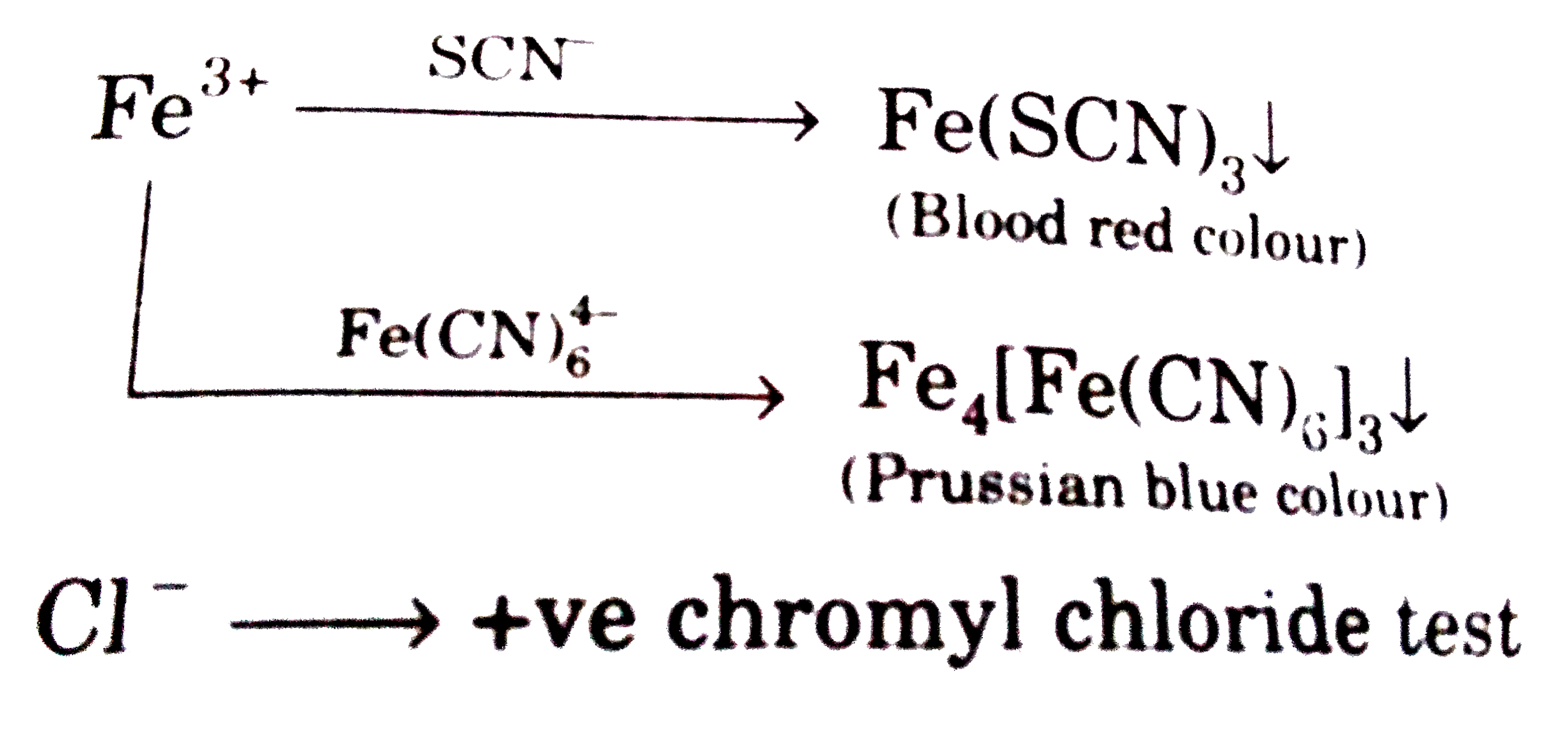An aqueous solution of a salt X turns blood red on treatment with SCN− and blue on treatment with K4[Fe(CN)6].X also gives a positive chromyl chloride test. The salt X is:
FeCI3
Fe(NO3)3
Cu(NO3)2
CuCI2
The correct Answer is:A

CI−→+ve chromyl chloride test
Topper's Solved these Questions
- SALT ANALYSISBook:GRB PUBLICATIONChapter:SALT ANALYSISExercise:J: IVth Group Cations
Explore 24 Videos
- SALT ANALYSISBook:GRB PUBLICATIONChapter:SALT ANALYSISExercise:K: Vth and Vth Group Cations
Explore 10 Videos
- SALT ANALYSISBook:GRB PUBLICATIONChapter:SALT ANALYSISExercise:H: IInd Group Cations
Explore 49 Videos
- S BLOCK ELEMENTSBook:GRB PUBLICATIONChapter:S BLOCK ELEMENTSExercise:SUBJECTIVE TYPE
Explore 9 Videos
- THERMODYNAMICSBook:GRB PUBLICATIONChapter:THERMODYNAMICSExercise:All Questions
Explore 704 Videos
Similar Questions
Knowledge Check
Cu2+ salts with K4[Fe(CN)6] gives
AReddish brown ppt.BDeep blue solutionCBlue ppt.DNone of these(i) An aqueous solution of a compound A is acidic towards litmus and A sublimes at about 300∘C
(ii) A solution of A, on treatment with an excess of NH4SCN, gives a red compound, and on treatment with a solution of K4[Fe(CN)6], gives a blue compound.
(iii) The solid A, on being heated with an excess of K2Cr2O7 in the presence of concentrated H2SO4, evolves deep red vapours of D.
(iv) On passing the vapours of D into a solution of NaOH and then adding the solution of acetic acid and lead acetate, a yellow precipitate of a compound E is obtained.
Q. Can compound A be prepared in the anhydrous form by strongly heating its hydrated crystals?ANo, because the water molecules are very stongly bound in the hydrated crystalsBNo, because the salt gets hydrolysed in the processCYes, because the water molecules are loosely bound in the hydrated crystalsDyes, because the salt sublimes at 300∘CA hydrated salt (x) gives golden yellow colour in flame test, given basic gas on treatement with NaOH, gives yellow ppt. on treatment with (NH4)2MoO4 and HNO3. It gives blue bead with Co2+ salt. The salt (x) is:
ANaAIO2.2H2OBNa2SO4.10H2OCNa2B4O7.10H2ODNaNH4HPO4.4H2O
(i) An aqueous solution of a compound A is acidic towards litmus and A is sublimed at about 300∘ C.
(ii) A on treatment withh an excess of NH4SCN gives a red coloured B and on treatment with a solution of K4[Fe(CN)6] gives a red coloured compound B and on treatment withh a solution of K4[Fe(CN)6] gives a blue coloured compound C.
(iii) A on heating with excess of K2Cr2O7 in presence of concentrated H2SO4 evolves deep red vapours of D.
(iv) On passing the vapours of D into a solution of NaOH and then adding the solutions of acetic acid and lead acetate, a yellow precipitate of compound E is obtained. Identify A to E and give chemical equations for the reactions at steps (ii) to (iv).
View SolutionA compound 'X' on treatment with Br2NaOH, provided C3H9N, which gives positive cabylamine test. Compound 'X' is:
View SolutionA compound 'X' on treatment with Br2/NaOH, provided C3H9N, which gives positive cabylamine test. Compound 'X' is :
View SolutionWhich of the following aqueous solution shas osmotic presseure nearest to that of an equimolar solution of K4[Fe(CN)6]
View SolutionFerric ion forms a prussian blue coloured solution with K4[Fe(CN)6] due to the formation of -
View Solution